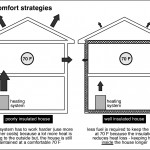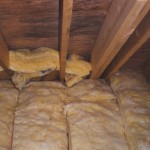Fiberglass Insulation: History, Hazards and Alternatives
 Fiberglass is a type of fiber primarily composed of glass that is used in a wide variety of applications, and is predominantly employed as a residential and commercial thermal insulator. Fiberglass is also used to create products as varied as automobile bodies, boat hulls, arrows, roofing, shower curtains, and tent poles. As an insulator, it slows the spread of heat, cold and sound in structures, cars and aircraft. By trapping pockets of air, it keeps rooms warm in the winter and cool in the summer and thereby serves as a convenient method to increase energy efficiency. Fiberglass is an attractive choice for home insulation because it poses no fire hazard. According to some estimates, thermal insulation (made from fiberglass and its alternatives) conserves 12 times as much energy as is lost in its production, and it may reduce residential energy costs by up to 40%.
Fiberglass is a type of fiber primarily composed of glass that is used in a wide variety of applications, and is predominantly employed as a residential and commercial thermal insulator. Fiberglass is also used to create products as varied as automobile bodies, boat hulls, arrows, roofing, shower curtains, and tent poles. As an insulator, it slows the spread of heat, cold and sound in structures, cars and aircraft. By trapping pockets of air, it keeps rooms warm in the winter and cool in the summer and thereby serves as a convenient method to increase energy efficiency. Fiberglass is an attractive choice for home insulation because it poses no fire hazard. According to some estimates, thermal insulation (made from fiberglass and its alternatives) conserves 12 times as much energy as is lost in its production, and it may reduce residential energy costs by up to 40%.Glass has been woven into small amounts of coarse fibers for many centuries, even by the ancient Egyptians and Phoenicians, but fiberglass did not exist in its modern form until 1932 as a result of an accident. A researcher named Dale Kleist was attempting to create a vacuum-tight seal between two glass blocks when a jet of high-pressure air turned a stream of molten glass into fine fibers. He had unintentionally discovered an effective method to produce large amounts of fiberglass particles, a method that he would refine in later years. Fiberglass was trademarked in 1938 as Fiberglas® and was subsequently used in clothing, boat hulls, fishing rods, and eventually automobile bodies in 1953 when Fiberglas® partnered with Chevrolet.
In homes, fiberglass insulation can be installed in various parts of the building envelope. It can be pink, yellow, white or green, depending on its manufacturer, and has a spongy feel. Commonly found in blanket form, called batts, it is available in bags containing standard pre-cut lengths and widths. Batts are typically stapled into place. It also comes in bags as loose fill that can be blown into attic, wall and floor cavities. Most fiberglass batts are manufactured with a paper or foil backing that faces the direction of warmth. When installed correctly, it creates a continuous membrane that retards the passage of moisture and reduces the likelihood that fibrous particles will enter the living space. It is important that the backing always faces the warm side of the structure in which the insulation is installed.
Batts are available in different thicknesses, with the thicker batts offering a higher resistance to heat flow. This resistance is known as R-value, with common R-values for walls being R11 to R19, and R30 to R38 for ceilings.
According to the EnergyStar™ Program, heating and cooling costs can be slashed by up to 20% per year by properly sealing and insulating the home. Insulating the attic should be a top priority for preventing heat loss because as heat rises, a critical amount of heat loss from the living areas of the home occurs through an unfinished attic. During the summer months, heat trapped in the attic can reduce a home’s ability to keep cool, forcing occupants to further tax the home’s cooling system.
The aim should be to insulate the living space of the house while allowing the roof to remain the same temperature as the outside. This prevents cold outside air from traveling through the attic and into the living area of the home. In order to accomplish this, an adequate venting system must be in place to vent the roof by allowing air flow to enter through soffit-intake vents and out through ridge vents, gable vents or louver vents.
If there is currently a floor in the attic, it will be necessary to pull up pieces of the floor to install the insulation. In this case, it will be easier to use a blower and loose-fill insulation to effectively fill the spaces between the joists. If you choose to go with blown-in insulation, you can usually get free use of a blower when you purchase a certain amount of insulation.
When installing fiberglass insulation, make sure that you wear personal protective equipment, including a hat, gloves, and a face mask, as stray fiberglass material can be inhaled and cause irritation to the lungs, eyes and exposed skin.
Before you begin actually installing the insulation, there is some important preparation involved in order to ensure that the insulation is applied properly to prevent hazards and to achieve maximum effectiveness.
 In order to maintain the free flow of outside air, it is recommended that polystyrene or plastic roof baffles are installed where the joists meet the rafters. These can be stapled into place. No having soffit baffles installed is one of the major causes of “ice dams” in winter months.
In order to maintain the free flow of outside air, it is recommended that polystyrene or plastic roof baffles are installed where the joists meet the rafters. These can be stapled into place. No having soffit baffles installed is one of the major causes of “ice dams” in winter months.Most builders will install a soffit baffle every 3 rafter or truss cavity. Home owners typically install one in every cavity or at least in every other cavity. Most roofs only require 1 square foot of ventilation for every 300 sq ft. This is usually split between soffit and upper roof. The building code requires a minimum of 25% to come from soffits and peaks.
Turbine vents are very popular but most people fail to realize that they let in both snow and rain. I always recommend placing an extra batt of fiberglass insulation below turbines to collect any moisture and let the attic ventilation dissipate the moisture naturally. I have also come across large plastic bowls being used under turbine.Hazards
It is important for home inspectors to understand the health risks associated with exposure to fiberglass insulation. These risks are not, at present, fully understood or agreed upon, but it is generally accepted that, in certain situations, it has the potential to cause physical harm. Small particles that come into contact with skin can lodge in pores and cause itchiness, rashes and irritation. When inhaled, particles can cause coughing, nosebleeds, and other respiratory ailments. Very fine airborne particles are capable of becoming deeply lodged in the lungs and are believed by many to cause cancer and other serious afflictions. OSHA considers this threat to be serious enough that it requires fiberglass insulation to carry a cancer warning label.
When it is disturbed, fiberglass insulation releases particulates into the air which may be inhaled by those installing or removing it, or by property inspectors crawling through attics or crawlspaces.
If you must disturb fiberglass insulation, wear gloves, long-sleeved shirts, pants and goggles. A respirator with a particulate filter should be used to prevent inhalation of the potentially dangerous fibers.
Before removing fiberglass insulation, it is a good idea to dampen the area to prevent particles from entering the airspace. Afterwards, wash your hands with water, preferably cold water, as warm water can expand pores which have trapped particles and allow them to travel deeper into your skin.
An Alternative – Cellulose
Cellulose, a plant-based insulator, is the oldest form of home insulation and, at times, has been produced from sawdust, cotton, straw, hemp, and other plant materials with low thermal-conductivity. Today, it is produced from recycled newspapers that are later treated with chemicals that reduce its ignition potential. It became popular in the 1970s due to the oil crisis, although it suffered from competition with fiberglass insulation as a result of fire-standards lobbying by the fiberglass and mineral companies. Cellulose must be chemically treated in order to reduce its flammable properties, although it always has the potential to burn. These chemicals, usually sodium borate, boric acid, or ammonium sulfate, are generally considered safe for human contact.
This material provides a number of advantages over fiberglass – it is inexpensive, significantly reduces airflow, and is not believed to pose any serious health risks. It is possible that the material can produce harmful off-gasses from the ink contained in the newspapers, but insulation is generally contained in sealed locations, so this is not likely to be a health concern. As is true with fiberglass, protect your lungs with a breathing mask when handling cellulose insulation.
Fiberglass and cellulose are both used as insulators, although they offer somewhat different advantages. Also, keep in mind that there are other types of thermal insulation available that are not covered in this article, such as rock wool, vermiculite, and various two-part foams.
Click here to view actual home inspection defect pictures by the Barrie Home Inspector

Recent Comments